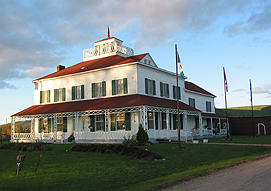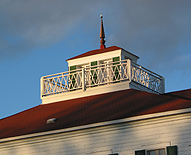 This is not a typical Outaouais farmhouse. For George Bryson (1813-1900), farming was a sideline. He became the richest baron in the Ottawa Valley; he represented the people of the Pontiac in the Legislative Assembly; Fort Coulonge grew up around his mills; he ran a home-furnishing business; he built many stone buildings and the Marchand bridge in Fort Coulonge; he was the mayor of the municipality; and, if that were not enough, he founded the Bank of Ottawa, which has now become the Scotia Bank.George Bryson emigrated from Paisley, Scotland in the 1820s.
This is not a typical Outaouais farmhouse. For George Bryson (1813-1900), farming was a sideline. He became the richest baron in the Ottawa Valley; he represented the people of the Pontiac in the Legislative Assembly; Fort Coulonge grew up around his mills; he ran a home-furnishing business; he built many stone buildings and the Marchand bridge in Fort Coulonge; he was the mayor of the municipality; and, if that were not enough, he founded the Bank of Ottawa, which has now become the Scotia Bank.George Bryson emigrated from Paisley, Scotland in the 1820s.
This farm of 780 acres and seven barns helped to supply the lumber camps, and was Bryson’s home until the 1860s. He made his fortune in white pine timber which was exported to Scotland and England, when “Brittania Ruled the Waves.” The third floor belvedere of this house gave him a view of the logs moving down the Coulonge River towards the Ottawa.
 Bryson built a 3,000-foot water chute for timber along a canyon wall to transport logs over the 150-foot falls of the Coulonge River and prevent their being smashed by the rapids. He charged other lumber people to use his chute. The last raft of square-cut timber sent down the Ottawa in 1909 came from the Coulonge.
Bryson built a 3,000-foot water chute for timber along a canyon wall to transport logs over the 150-foot falls of the Coulonge River and prevent their being smashed by the rapids. He charged other lumber people to use his chute. The last raft of square-cut timber sent down the Ottawa in 1909 came from the Coulonge.
George Bryson was not universally popular, understandable when one considers that he had his hands in produce, trade, politics, and money. He was, however, a pioneer in the development of the Outaouais; he often spoke in the Legislative Assembly on behalf of Ottawa Valley interests; and he encouraged people to stay and develop the region.